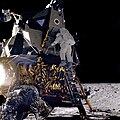The International Lunar Network or ILN is a proposed network of a series of landed stations of the United States and the other space-faring countries on the lunar surface in the 2010s. Each of these stations will act as a node in a lunar geophysical network. Ultimately this network could comprise 8-10 or more nodes operating simultaneously. In the ILN concept, each node will have a minimum of two core capabilities. These capabilities include seismic sensing, heat flow sensing, and laser retroreflectors, and will be specific to each station. Because some nodes are planned to be located on the far side of the Moon, NASA will study a lunar communications relay satellite capability as a part of its contribution to this project.[1] Individual nodes launched by different space agencies can and likely will carry additional, unique experiments to study local or global lunar science. Such experiments might include atmospheric and dust instruments, plasma physics investigations, astronomical instruments, electromagnetic profiling of lunar regolith and crust, local geochemistry, and in-situ resource utilization demonstrations.[1]
History[]
On July 24, 2008 a meeting of the space agencies of Canada, France, Germany, India, Italy, Japan, the Republic of Korea, the United Kingdom, and the United States was held at NASA's Lunar Science Institute, located at the Ames Research Center. During the meeting, the representatives of the nine space agencies discussed about the cooperation on ILN and agreed on a statement of intent as a first step in planning. NASA’s Science Mission Directorate (SMD) and Exploration Systems Mission Directorate (ESMD) have agreed to provide two pairs of nodes (landed stations) for this network.
The first two nodes were to be launched in 2013 and 2014, with the second pair being launched some time between 2016 and 2017. However, the new planning date for launch of the first node is March 1, 2018.[1] The landers are being developed under the Lunar Precursor Robotic Program at NASA's Marshall Space Flight Center in Huntsville, Alabama.[2]
References[]
- ↑ 1.0 1.1 1.2 "International Lunar Network". http://nasascience.nasa.gov/missions/iln. Retrieved 2008-08-12.
- ↑ "NASA Hosts International Meeting for Lunar Science Discussions". http://www.nasa.gov/home/hqnews/2008/jul/HQ_08190_NASA_hosts_ILN.html. Retrieved 2008-08-12.
External links[]
| |||||||||||||||||||||||||||||||||||||||||||||||||||
| This page uses Creative Commons Licensed content from Wikipedia (view authors). | 
|


